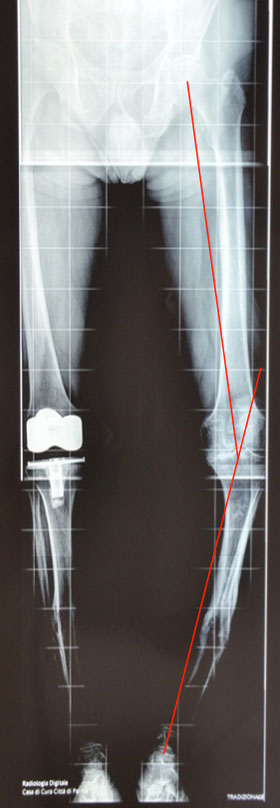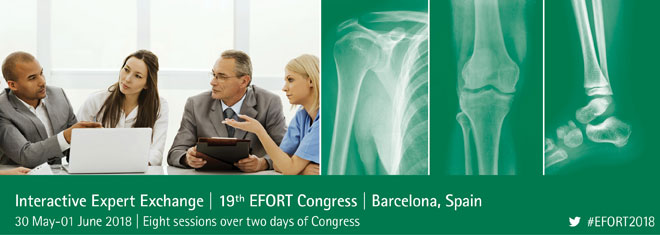What experts do: Total knee arthroplasty in severe deformities

To address the medical options regarding total knee arthroplasty in patients with severe deformities, the upcoming EFORT Congress in Barcelona will provide a concise 2-hour overview of this difficult scenario via the Interactive Expert Exchange (IEE) session led by Prof. Paolo Adravanti, head of the orthopaedic department at Casa di Cura Citta ‘Di Parma in Italy.
In most cases, severe deformities in patients undergoing knee surgery significantly challenge orthopaedic surgeons as usual treatment approaches face important limitations or are impossible to achieve. A well-aligned limb is of paramount importance to reduce the forces that put the implant at risk of mobilization. Not only does knee alignment influence the functioning of prostheses and the satisfaction of the patient, but, in general, any limb alignment is crucial for an adapted correction.
Majority of knee deformities are post-traumatic or congenital, and, in few cases, they have a metabolic etiology. Abnormalities in the knee growth can occur in the inner or the outer side of the knee. This unequal growth results in knees with either varus (bow legs) or valgus (knock knee) deformities. In early stages of the deformity development, problems are mainly cosmetic and can yield to mild limping in the patient. In later stages, wear that occurs around the knee joint leads to osteoarthritis.

According to their location, deformities are classified as intra-articular or extra-articular (when located beyond the attachments of the collateral ligaments). But, in both cases, the treatment usually indicated is surgical correction to re-align the bones. Practically, depending on the anatomical features of the deformity, the alignment is restored acting either extra-articularly — through corrective osteotomy at the focus of the deformity, compensatory osteotomy when the correction is performed proximally or distally to the focus of the deformity — or intra-articularly, through aggressive soft-tissue release and bony cuts, with or without using constrained implants. In some specific cases, epicondylar osteotomy is necessary.
For instance, lateral epicondyle sliding osteotomy is indicated in the setting of a fixed valgus knee from femoral origin. Moreover, in stiff or sub-ankylosed knees, ligaments and periarticular tissues are contracted. Aggressive release of those structures is imperative to gain a wider range of motion, but this can lead to a flexion/extension gap mismatch. Therefore, it is recommended to have constrained type implants available when dealing with patients with such conditions.
TKA in Severe Deformities
Thursday 31 May 2018 | 10:00 – 12:15
Introduction & Conclusions
Paolo Adravanti (Italy)
Questions & Presentations
TKA in severe varus deformities | Emmanuel Thienpont (Belgium)
TKA in severe valgus deformities | Philip Chapman-Sheath (United Kingdom)
TKA in flexion contracture | Andreas Halder (Germany)
Correction of extraarticular deformities | Paolo Adravanti (Italy)
Sub-ankylosed knee | Michel Bonnin (France)
Discussion on Clinical Cases
Francesco Bennazzo (Italy) and Thomas Paszicsnyek (Austria)
Several unavoidable questions will be answered during the presentations, such as whether a varus knee without an ACL and with posteromedial wear needs release, how ligament balancing in the severe valgus deformity should be performed, what are the risk factors of a persistent flexion contracture after TKA, and how the correct indication of knee arthrodesis or TKA can be selected in a patient with a sub-ankylosed knee.
Discussions around these important matters will allow the audience to bring to the front the most convenient treatment for both varus and valgus deformities, as well as extra-articular irregularities, and will provide an overview of key evidence to better execute knee arthroplasty in cases of knees with flexion contracture or that are sub-ankylosed.
The highly interactive format of these sessions will combine current knowledge on treatment of severely deformed knees with intense discussions highlighting difficult cases where surgical execution of TKA does not adhere to common operative planning. Specialists and practitioners attending this IEE will benefit from the in-depth analysis of complex situations by renowned experts to improve their skills and ease their daily practice within the field of TKA.
IEEs are paying sessions and pre-registration is mandatory on a first-come, first-serve basis (maximum of 200 participants). Only participants with a full registration for the Congress can attend the IEE sessions. All details to sign-up are available on the registration platform. Visit the Barcelona congress website regularly.
- For more information:
- 19th EFORT Congress in Barcelona | 30 May to 1 June 2018
- Interactive Expert Exchange sessions
- Registration platform

